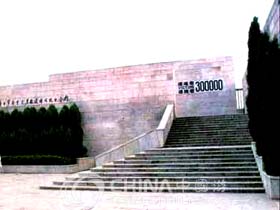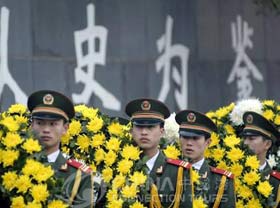
 Nanjing Massacre Memorial has outdoor exhibits, a historical museum and a building housing the remains of some of those killed during the World War II Japanese invasion of Nanjing. The Memorial, built in 1985, is an imposing and solemn construction. This memorial was set up on the site of "Jiangdong Men Wanrenken", where 10,000 local residents were killed and buried by Japanese invaders at one time. Covering 25,000 square meters with main buildings taking up 2,100 square meters, the memorial was meant to commemorate the thrilling past known as "Nanjing Massacre", during which 300,000 citizens were killed in a few days in 1937 in the WW II. The Museum documents the Japanese invasion via graphic pictures, a viewing hall and a display of the furniture that was used during the signing of the Japanese surrender. Thirteen tablets erected in the courtyard record this massacre by writings about bad deeds conducted by Japanese invaders. The only heartening exhibit in this otherwise grim museum, shows the improvement in Sino-Japanese relations with letters from Japanese schoolchildren apologizing for their country wartime aggression.
Nanjing Massacre Memorial has outdoor exhibits, a historical museum and a building housing the remains of some of those killed during the World War II Japanese invasion of Nanjing. The Memorial, built in 1985, is an imposing and solemn construction. This memorial was set up on the site of "Jiangdong Men Wanrenken", where 10,000 local residents were killed and buried by Japanese invaders at one time. Covering 25,000 square meters with main buildings taking up 2,100 square meters, the memorial was meant to commemorate the thrilling past known as "Nanjing Massacre", during which 300,000 citizens were killed in a few days in 1937 in the WW II. The Museum documents the Japanese invasion via graphic pictures, a viewing hall and a display of the furniture that was used during the signing of the Japanese surrender. Thirteen tablets erected in the courtyard record this massacre by writings about bad deeds conducted by Japanese invaders. The only heartening exhibit in this otherwise grim museum, shows the improvement in Sino-Japanese relations with letters from Japanese schoolchildren apologizing for their country wartime aggression.
Now this is believed to be the best evidence to fight against the distortion of history by some Japanese military officials. On the anniversary of the Invasion, various kinds of social activities are held at home and abroad to pay homage to the deaths, and what's more to remind the populace of the horrific past and therefore to prevent the same tragedy happen again.
 The Museum is a somber and depressing place but also provides an insight into the atrocities of 1937. The exhibition ends on a more positive note, documenting the Sino Japanese reconciliation talks in 1945. However, recent developments regarding right wing Japanese groups claiming that the severity of the massacre is exaggerated, may change this optimistic outlook. Nanjing residents greeted the Japanese claims with great dismay and distress and regard them as a personal affront.
The Museum is a somber and depressing place but also provides an insight into the atrocities of 1937. The exhibition ends on a more positive note, documenting the Sino Japanese reconciliation talks in 1945. However, recent developments regarding right wing Japanese groups claiming that the severity of the massacre is exaggerated, may change this optimistic outlook. Nanjing residents greeted the Japanese claims with great dismay and distress and regard them as a personal affront.

